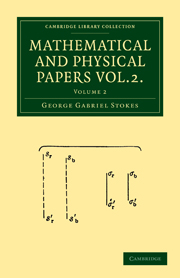Book contents
- Frontmatter
- Contents
- Notes on Hydrodynamics. III. On the Dynamical Equations
- On the constitution of the Luminiferous Ether
- On the Theory of certain Bands seen in the Spectrum
- Notes on Hydrodynamics. IV. Demonstration of a Fundamental Theorem
- On a difficulty in the Theory of Sound
- On the Formation of the Central Spot of Newton's Rings beyond the Critical Angle
- On some points in the Received Theory of Sound
- On the perfect Blackness of the Central Spot in Newton's Rings, and on the Verification of Fresnel's Formula for the intensities of Reflected and Reflacted Rays
- On Attractions, and on Clairaut's Theorem
- On the Variation of Gravity at the Surface of the Earth
- On a Mode of Measuring the Astigmatism of a Defective Eye
- On the Determination of the Wave Length corresponding with any Point of the Spectrum
- Discussion of a Differential Equation relating to the Breaking of Railway Bridges
- Notes on Hydrodynamics, VI. On Waves
- On the Dynamical Theory of Diffraction
- On the Numerical Calculation of a class of Definite Integrals and Infinite Series
- On the Mode of Disappearance of Newton's Rings in passing the Angle of Total Internal Reflection
- On Metallic Reflection
- On a Fictitious Displacement of Fringes of Interference
- On Haidinger's Brushes
- Index
On Metallic Reflection
Published online by Cambridge University Press: 07 September 2010
- Frontmatter
- Contents
- Notes on Hydrodynamics. III. On the Dynamical Equations
- On the constitution of the Luminiferous Ether
- On the Theory of certain Bands seen in the Spectrum
- Notes on Hydrodynamics. IV. Demonstration of a Fundamental Theorem
- On a difficulty in the Theory of Sound
- On the Formation of the Central Spot of Newton's Rings beyond the Critical Angle
- On some points in the Received Theory of Sound
- On the perfect Blackness of the Central Spot in Newton's Rings, and on the Verification of Fresnel's Formula for the intensities of Reflected and Reflacted Rays
- On Attractions, and on Clairaut's Theorem
- On the Variation of Gravity at the Surface of the Earth
- On a Mode of Measuring the Astigmatism of a Defective Eye
- On the Determination of the Wave Length corresponding with any Point of the Spectrum
- Discussion of a Differential Equation relating to the Breaking of Railway Bridges
- Notes on Hydrodynamics, VI. On Waves
- On the Dynamical Theory of Diffraction
- On the Numerical Calculation of a class of Definite Integrals and Infinite Series
- On the Mode of Disappearance of Newton's Rings in passing the Angle of Total Internal Reflection
- On Metallic Reflection
- On a Fictitious Displacement of Fringes of Interference
- On Haidinger's Brushes
- Index
Summary
The effect which is produced on plane-polarized light by reflexion at the surface of a metal, shews that if the incident light be supposed to be decomposed into two streams, polarized in and perpendicularly to the plane of reflexion respectively, the phases as well as the intensities of the two streams are differently affected by the reflexion. It remains a question whether the phase of vibration of the stream polarized in the plane of reflexion is accelerated or retarded relatively to that of the stream polarized perpendicularly to the plane of reflexion. This question was first decided by the Astronomer Royal, by means of a phenomenon relating to Newton's rings when formed between a speculum and a glass plate. Mr Airy's paper is published in the Cambridge Philosophical Transactions. M. Jamin has since been led to the same result, apparently by a method similar in principle to that of Mr Airy. In repeating Mr Airy's experiment, the author experienced considerable difficulty in observing the phenomenon. The object of the present communication was to point out an extremely easy mode of deciding the question experimentally. Light polarized at an azimuth of about 45° to the plane of reflexion at the surface of the metal was transmitted, after reflexion, through a plate of Iceland spar, cut perpendicular to the axis, and analysed by a Nicol's prism.
- Type
- Chapter
- Information
- Mathematical and Physical Papers , pp. 360Publisher: Cambridge University PressPrint publication year: 2009First published in: 1883

